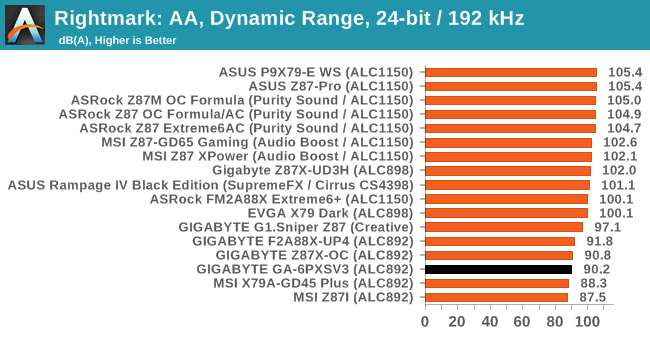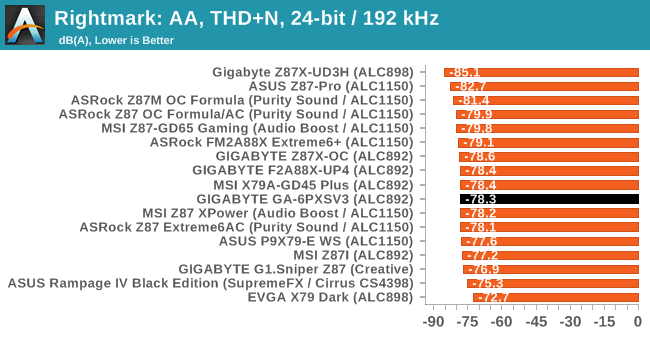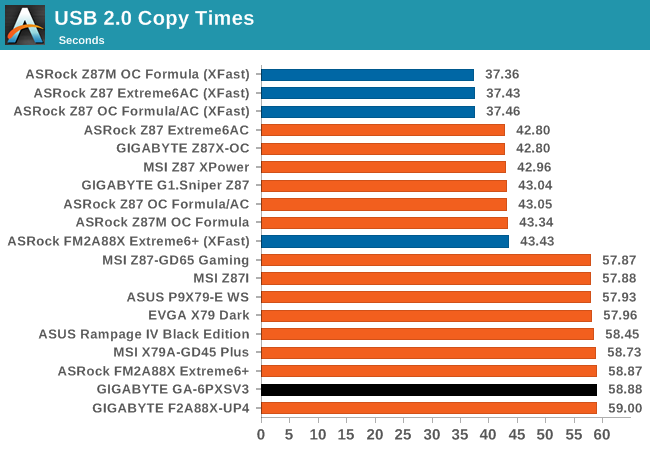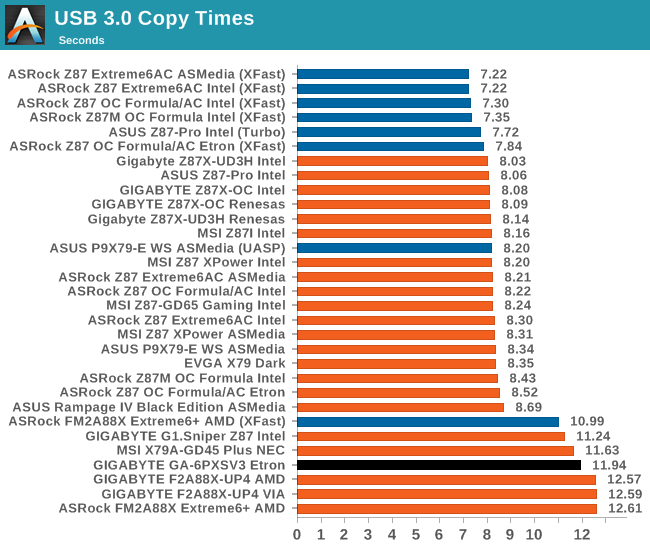GIGABYTE GA-6PXSV3 Review
by Ian Cutress on March 31, 2014 11:59 AM EST- Posted in
- Motherboards
- Gigabyte
- SLI
- CrossFire
- X79
- Enterprise
- C604
System Benchmarks
Rightmark Audio Analyzer 6.2.5
The premise behind Rightmark:AA is to test the input and output of the audio system to determine noise levels, range, harmonic distortion, stereo crosstalk and so forth. Rightmark:AA should indicate how well the sound system is built and isolated from electrical interference (either internally or externally). For this test we connect the Line Out to the Line In using a short six inch 3.5mm to 3.5mm high-quality jack, turn the OS speaker volume to 100%, and run the Rightmark default test suite at 192 kHz, 24-bit. The OS is tuned to 192 kHz/24-bit input and output, and the Line-In volume is adjusted until we have the best RMAA value in the mini-pretest. We look specifically at the Dynamic Range of the audio codec used on board, as well as the Total Harmonic Distortion + Noise.
Dynamic Range of the GIGABYTE GA-6PXSV3


Being a server motherboard, we were not expecting any superior sound quality. GIGABYTE are using a Realtek ALC892 codec which represents the bottom of the ‘expected’ range for any consumer level motherboard priced above $100. These results are in line with what we expect with this chip.
USB Backup
For this benchmark, we run CrystalDiskMark to determine the ideal sequential read and write speeds for the USB port using our 240 GB OCZ Vertex3 SSD with a SATA 6 Gbps to USB 3.0 converter. Then we transfer a set size of files from the SSD to the USB drive using DiskBench, which monitors the time taken to transfer. The files transferred are a 1.52 GB set of 2867 files across 320 folders – 95% of these files are small typical website files, and the rest (90% of the size) are the videos used in the WinRAR test. In an update to pre-Z87 testing, we also run MaxCPU to load up one of the threads during the test which improves general performance up to 15% by causing all the internal pathways to run at full speed.


DPC Latency
Deferred Procedure Call latency is a way in which Windows handles interrupt servicing. In order to wait for a processor to acknowledge the request, the system will queue all interrupt requests by priority. Critical interrupts will be handled as soon as possible, whereas lesser priority requests, such as audio, will be further down the line. So if the audio device requires data, it will have to wait until the request is processed before the buffer is filled. If the device drivers of higher priority components in a system are poorly implemented, this can cause delays in request scheduling and process time, resulting in an empty audio buffer – this leads to characteristic audible pauses, pops and clicks. Having a bigger buffer and correctly implemented system drivers obviously helps in this regard. The DPC latency checker measures how much time is processing DPCs from driver invocation – the lower the value will result in better audio transfer at smaller buffer sizes. Results are measured in microseconds and taken as the peak latency while cycling through a series of short HD videos - less than 500 microseconds usually gets the green light, but the lower the better.

We tested the latency of the GA-6PXSV3 on three different CPUs, and surprisingly the Core i7 consumer CPU scored the worst value.











12 Comments
View All Comments
mooninite - Monday, March 31, 2014 - link
I wouldn't recommend this board since it includes 82574L NICs that have known hardware errata that I have suffered myself. They are also quite old now (3+ years). Any new server board will include I350-based NICs and these seem to be rock solid in my testing.extide - Monday, March 31, 2014 - link
Odd that they left the remaining 8 PCIe lanes un-used. It would have been a better idea to route them to that last PCIe slot, instead of that slot using 2 lanes from the chipset.TeXWiller - Monday, March 31, 2014 - link
Do you have any experience with the i210 series? That seems to be the new value choice after the 82574L.Samus - Monday, March 31, 2014 - link
its funny you mention that, I had HP replace a motherboard in one of my clients Pro 4300 SFF workstations and the new board had an i210, the old board had a Broadcom, so it seems people are moving toward the i210 on the newest hardware revisions.mooninite - Tuesday, April 1, 2014 - link
i210 would be fine. Anything except 82574L...Ktracho - Monday, March 31, 2014 - link
Any chance of getting a screen shot of the BIOS screen for Advanced/PCI Subsystem Settings? We are very interested in a motherboard that supports the latest NVIDIA Tesla / Xeon Phi boards (which the GA-7PESH3 motherboard support), but we have not been able to find specific information about this Gigabyte motherboard. The key would be for the BIOS screen to have a setting for "PCI 64bit Resources Handling"/"Above 4G Decoding". Can you confirm if this setting exists for the GA-6PXSV3? ASUS has a competing motherboard with a similar setting in the BIOS, but it does not meet our requirements.Ian Cutress - Monday, March 31, 2014 - link
It's in the gallery, third picture along.http://www.anandtech.com/Gallery/Album/3508#3
yuhong - Tuesday, April 1, 2014 - link
"The GIGABYTE BIOS may not be UEFI"It is UEFI, notice the UEFI shell item.
BMNify - Tuesday, April 1, 2014 - link
"GIGABYTE Server GA-6PXSV3 we are reviewing today is aiming to supply enough at the lower end of the extreme workstation segment."its hard to pick the April fool news as this cant be considered "the lower end of the extreme workstation segment." at 349€95 http://www.ldlc.com/fiche/PB00140021.html surely, with only a single socket and not enough PCI-E slots to fill with a reasonable amount of fast PCI-E SSD's plus gfx cards....
toyotabedzrock - Tuesday, April 1, 2014 - link
I had a workstation board by supermicro in the slot 1 era of P2 and P3 and it's bios was very graphical and used a mouse. I don't understand why the bios interface went from that to an 80s era design and stayed there.